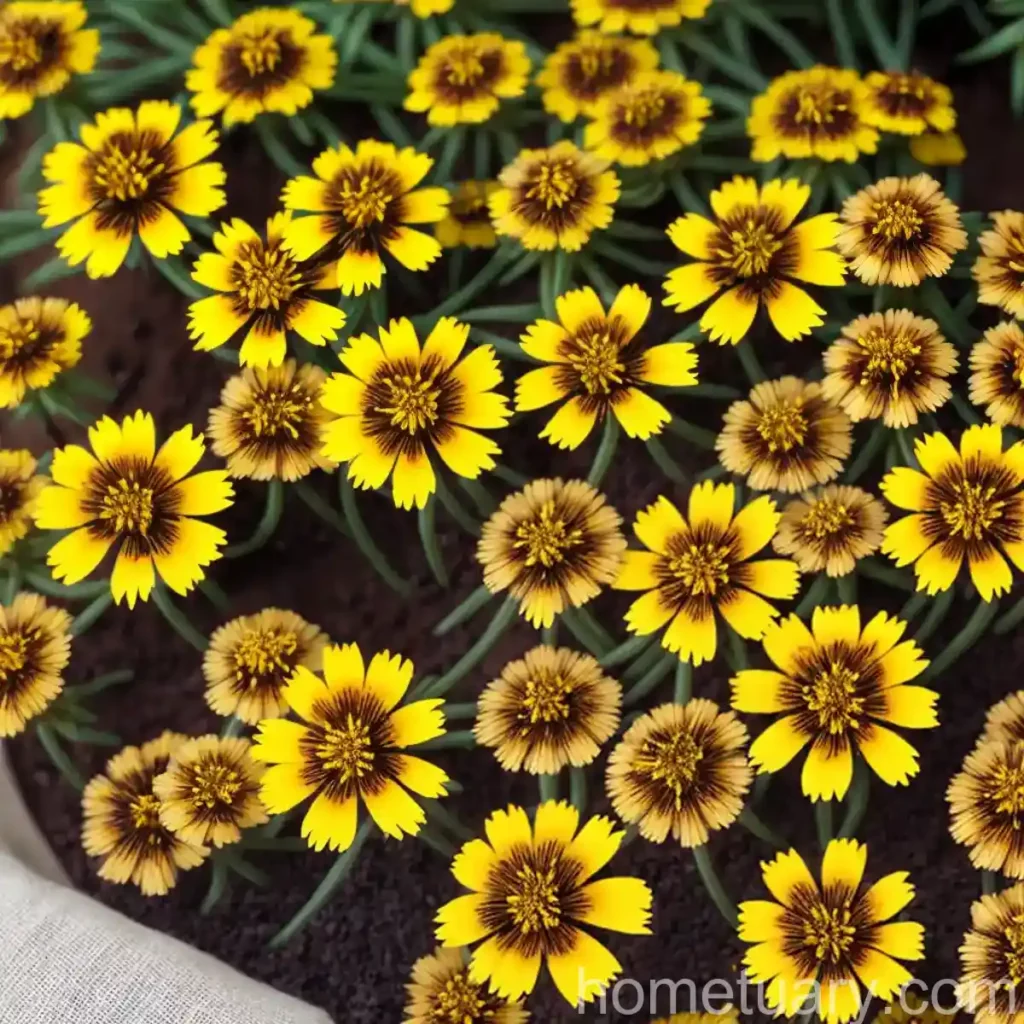Plant Scientist’s Guide to Tickseed (Coreopsis ‘Creme Brulee’)
The tickseed, Coreopsis ‘Creme Brulee’, is a beautiful and popular perennial flower variety that is beloved by gardeners for its vibrant yellow blooms and easy-care nature. As a plant scientist, I am excited to share a comprehensive guide to this stunning plant, covering its culture, uses, care, propagation, common diseases, and more. Whether you are a seasoned gardener or just starting, there is something for everyone to learn about this wonderful plant.
What is the Tickseed (Coreopsis ‘Creme Brulee’)?
The tickseed, scientifically known as Coreopsis ‘Creme Brulee’, is a cultivar of the Coreopsis genus, renowned for its profusion of golden-yellow, daisy-like flowers that adorn its fine-textured foliage. This charming perennial is a member of the Asteraceae family and is native to North America. Its compact and mounding growth habit, coupled with its long blooming period, makes it a sought-after addition to gardens and landscapes.
Key Takeaways – Tickseed (Coreopsis ‘Creme Brulee’)
Before delving into the detailed aspects of the tickseed plant, let’s cover some key takeaways about this delightful variety:
- The tickseed (Coreopsis ‘Creme Brulee’) is a perennial flower known for its stunning golden-yellow blooms.
- It is a cultivar of the Coreopsis genus and belongs to the Asteraceae family.
- This variety is prized for its long blooming period and fine-textured foliage.
- Tickseed ‘Creme Brulee’ is a low-maintenance plant that is suitable for a variety of garden settings.
Culture
To successfully cultivate and enjoy the beauty of tickseed (Coreopsis ‘Creme Brulee’), it is essential to understand its cultural requirements, including water, sunlight, fertilizer, soil, and pruning needs.
Water
Tickseed plants, including the ‘Creme Brulee’ variety, prefer moderate moisture levels. While they are moderately drought-tolerant once established, it is important to provide consistent watering, especially during prolonged dry spells or in regions with hot summer temperatures. Avoid overwatering, as excessive moisture can lead to root rot and other issues.
Sunlight
One of the key factors contributing to the success of tickseed plants is ample sunlight. Coreopsis ‘Creme Brulee’ thrives in full sun to partial shade, with a preference for at least 6 hours of direct sunlight per day. Adequate sunlight promotes healthy growth, prolific flowering, and overall vitality of the plant.
Fertilizer
When it comes to fertilization, tickseed (Coreopsis ‘Creme Brulee’) benefits from a well-balanced, granular, slow-release fertilizer applied in early spring as new growth emerges. A fertilizer with a formulation such as 10-10-10 or 5-10-5, which provides a balance of nitrogen (N), phosphorus (P), and potassium (K), can support healthy foliage and abundant blooms.
Soil
Tickseed ‘Creme Brulee’ thrives in well-draining soil with a slightly acidic to neutral pH range. Rich, loamy soils are ideal for promoting robust growth and flowering. If the native soil is heavy or clay-based, amending it with organic matter, such as compost or well-rotted manure, can improve its structure and drainage.
Pruning
Pruning tickseed plants, including the ‘Creme Brulee’ variety, is beneficial for maintaining their shape, enhancing flowering, and rejuvenating older plants. Deadheading, which involves removing spent blooms, encourages continuous flowering and prevents the plant from setting seed, thereby redirecting its energy into producing new flowers.
Uses
The versatility of tickseed (Coreopsis ‘Creme Brulee’) makes it a valuable addition to various garden settings and landscaping designs, offering an array of potential uses and applications.
- Garden Borders: The mounding habit and vibrant flowers of ‘Creme Brulee’ tickseed make it well-suited for use as a colorful border plant, adding character and charm to garden edges and pathways.
- Container Gardens: Due to their compact growth and striking blooms, Coreopsis ‘Creme Brulee’ plants are ideal for container gardens. They can be showcased on patios, balconies, or in mixed planters for a pop of bright color.
- Wildlife Gardens: The nectar-rich flowers of tickseed (Coreopsis ‘Creme Brulee’) attract pollinators, including bees and butterflies, making it a valuable addition to wildlife-friendly gardens and pollinator habitats.
- Cut Flower Arrangements: The long-lasting blooms of ‘Creme Brulee’ tickseed can be utilized in cut flower arrangements, bringing the beauty of the outdoors into interior spaces.
Propagation
Tickseed (Coreopsis ‘Creme Brulee’) can be propagated through various methods, allowing gardeners to expand their plant collection or share this stunning variety with fellow enthusiasts.
- Division: As an herbaceous perennial, Coreopsis ‘Creme Brulee’ can be propagated through division. This involves carefully digging up mature plants in early spring, separating the clumps into individual sections with healthy roots, and replanting them in suitable locations.
- Seed Propagation: While ‘Creme Brulee’ tickseed does produce seeds, it is important to note that it may not come true to the parent plant and can exhibit variations in flower color and other traits. Seed propagation involves collecting ripe seeds in the late summer or fall, sowing them in seed-starting trays, and providing suitable growing conditions for germination.
Container Popularity
The compact size, long bloom period, and low maintenance requirements of ‘Creme Brulee’ tickseed contribute to its popularity as a container plant, suitable for various settings and garden styles.
- Patio Containers: Coreopsis ‘Creme Brulee’ plants can be featured in patio containers, adding vibrant color and visual interest to outdoor spaces. Pairing them with complementary foliage plants or trailing vines can create striking container compositions.
- Balcony Gardens: For gardeners with limited outdoor space, ‘Creme Brulee’ tickseed is a delightful choice for balcony gardens, where its cheerful blooms can brighten up small, urban settings.
- Mixed Planters: Combining ‘Creme Brulee’ tickseed with other annuals or perennials in mixed planters allows for creative and dynamic arrangements, offering a harmonious blend of colors and textures.
Container Common Diseases
While growing tickseed (Coreopsis ‘Creme Brulee’) in containers offers numerous advantages, it is important to be aware of common diseases that can affect the plants in container settings and take preventive measures to maintain their health and vigor.
Disease Diagnosis
- Powdery Mildew: This fungal disease often manifests as powdery, white patches on the leaves and stems of tickseed plants. It can result from poor air circulation or excessive humidity, common conditions in container settings.
- Root Rot: Overwatering or poorly draining potting mix can lead to root rot, causing the plant’s roots to become waterlogged and eventually rot, leading to wilting and decline.
Common Pests
As with many plants, tickseed (Coreopsis ‘Creme Brulee’) is susceptible to certain pests that can affect its growth and appearance. Implementing proactive pest management strategies can help safeguard the health and beauty of the plants.
Botanist’s Tips
- Powdery Mildew Prevention: To prevent powdery mildew in container-grown ‘Creme Brulee’ tickseed, provide adequate space between containers to promote air circulation and choose a well-draining potting mix. Additionally, avoid overhead watering, as wet foliage can facilitate the development of powdery mildew.
- Container Drainage: When selecting containers for growing tickseed plants, ensure that they have adequate drainage holes to prevent waterlogging and reduce the risk of root rot.
Fun Facts
As a plant scientist, I’ve come across numerous interesting facts and observations about tickseed (Coreopsis ‘Creme Brulee’) that showcase its unique attributes and enrich its appeal to gardeners and nature enthusiasts.
- Attracts Pollinators: The abundant blooms of ‘Creme Brulee’ tickseed make it an attractive nectar source for bees, butterflies, and other beneficial pollinators, contributing to garden biodiversity.
- Longevity: Tickseed plants, including ‘Creme Brulee’, are known for their longevity when provided with suitable growing conditions, rewarding gardeners with years of vibrant blooms and beauty.
- Adaptability: While tickseed is native to North America, it exhibits adaptability to a range of climatic and soil conditions, making it a versatile and resilient garden plant.
- Low Maintenance: ‘Creme Brulee’ tickseed is celebrated for its low maintenance nature, requiring minimal care once established, making it an excellent choice for busy gardeners.
Links to External Resources
For more in-depth information and resources about tickseed (Coreopsis ‘Creme Brulee’), I recommend exploring the following links:
- The National Gardening Association – Coreopsis ‘Creme Brulee’
- University of Florida IFAS Extension – Tickseed Production Guide
- RHS Guide to Growing Tickseed
- The Old Farmer’s Almanac – Tickseed Growing Guide
In conclusion, the tickseed plant, particularly the ‘Creme Brulee’ variety, is a delightful and versatile addition to gardens and landscapes, offering a burst of sunny color, low maintenance requirements, and a host of beneficial qualities. By understanding its culture, propagation, common diseases, and use in containers, gardeners can cultivate and enjoy this charming perennial with confidence and success. Whether used in garden borders, containers, or wildlife-friendly landscapes, tickseed (Coreopsis ‘Creme Brulee’) is sure to brighten any outdoor space with its radiant blooms and enduring appeal.















